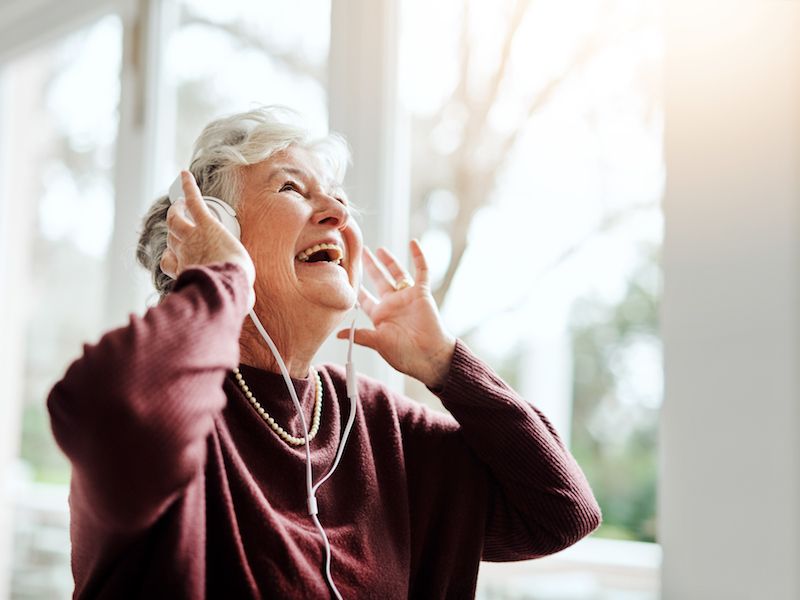
Noise-related loss of hearing doesn’t only impact individuals who work in loud environments, like construction workers or heavy metal roadies. It doesn’t even need to be work-related, recreation-related noise exposure can be damaging, too. The most prevalent kind? Music, gaming, streaming video or anything else that you would listen to through earbuds or headphones.
You may not think your smartphone or tablet can get that loud. The typical pain threshold for human hearing is close to 150 db which is in the range of these devices. This is the volume at which noise starts to literally hurt your ears. So what’s the answer for safeguarding your hearing against volume related injury.
It’s important here to think about the volume. Listen with the volume at no more than 60% for 60 minutes or less at a stretch (how long you listen for also makes a difference), this is known as the 60/60 rule.
Make a Setting on Your Hearing Aids For Listening to Music
If you use hearing aids, you’re most likely streaming your device right to your hearing aids, so make certain the volume is not too loud or that you’re not attempting to drown out other sounds with your music. And there are much healthier ways to listen to music so consult us about that also. If you’re a musician or real music aficionado you may have recognized that most hearing aids are programmed to sharpen the quality of voices…not necessarily music. While listening to music, we can most likely make a few adjustments to help enhance the quality of sound and minimize the feedback.
What Are The Best Headphones For You?
When getting headphones there are many choices, especially if you use hearing aids. There are a few things to think about, though it’s generally a matter of personal preference.
Over-the-Ear Headphones
While the foam-covered speakers that came with your old Walkman are generally a thing of the past, over-the-ear headphones have had a resurgence. Often shockingly costly, they offer lots of color options and celebrity endorsements, and of course, superior sound quality. And these headphones cover the whole ear limiting out noise, unlike those old foam ones.
Main-stream wisdom is that these are less dangerous than in-ear headphones because the source of the sound is further from your eardrum. But the truth is they’re often able to reach louder sound than the smaller kind, the speakers are a lot bigger. In addition, noise-canceling might help you ignore the crying baby on your flight, but in other circumstances, it can block sounds you need to hear (like a honking car). But on the positive side, you won’t need to contend with outside noise so you can enjoy your music at lower volumes.
Earbuds
The normal earbuds that come with devices such as iPhones are known for their poor quality of sound, although lots of people still use them because hey, they were included with the phone. Specifically, with newer Apple devices, it’s just easier to use the earbuds which were provided with the device because it probably won’t have a headphone jack.
The drawback, besides the poor sound quality, is that basic earbuds can’t block outside sounds, so you’re more likely to pump up the sound level. It’s commonly assumed that sticking earbuds so close to your eardrum is the main problem but it’s actually the volume.
Isolating or Occluding Earbuds
Many people prefer earbuds with a rounded, rubbery tip both because they’re more comfortable than standard earbuds and more effective at blocking outside noises. The rubber molds to the shape of your ear, creating a seal that stops other sounds from entering. Not to sound like a broken record, but these types of earbuds have the same disadvantages as the other two (volume is the main problem), as well as carrying the same caution as over-the-ear headphones (they can block out warning sounds). Needless to say, these won’t work for you if you use hearing aids.
You may need to test out more than one pair before you find headphones that are what you are looking for. Your expectations, acoustically, will differ dependant on what kind of usage you usually give them. Listening to your music at a healthy volume and coming across headphones that assist you in doing that is essential.
Don’t Cut Corners When Dealing With Your Hearing
Is it Safe, How Can I be certain? If you use a smartphone, you can get an app for that, you can get the National Institute for Occupational Safety and Health’s free Sound Level Meter app. There are different apps out there, but studies has found that the dependability of these other apps is spotty (additionally, for unknown reasons, Android-based apps have proven to be less precise). That motivated NIOSH to develop an app of their own. The app lets you measure external sounds, but it’s also possible to measure the sound coming from your device’s speakers, this means, the actual volume of what’s being sent to your ears. It’s a little bit of work, but taking these types of preventative steps can help safeguard your hearing.